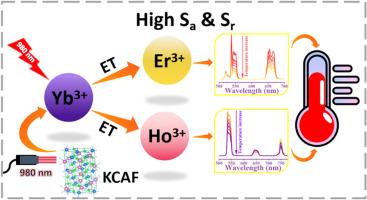钨青铜型KCaAl2F9:Er3+/Ho3+荧光粉中Yb3+敏化上转换实现了高灵敏度光学温度计
IF 3.6
3区 物理与天体物理
Q2 OPTICS
引用次数: 0
摘要
非接触式荧光温度传感技术因其无创操作、深入组织、近红外激发、灵敏度提高、自身荧光干扰小等优点,在生命科学和医学领域受到广泛关注。在这项工作中,我们报道了一种钨青铜型KCaAl2F9 (KCAF)宿主与Yb3+-Er3+/Ho3+离子共掺杂,在980 nm激发下实现了强烈的可见上转换发光(UCL)。这是由于在独特的晶体场环境中,从Yb3+敏化剂到Er3+/Ho3+激活剂的有效能量转移。通过对镧系离子浓度的系统优化,我们设计了三个不同的荧光强度比测温通道:(1)FIR1 (I521 nm/I538 nm, Er3+), (2) FIR2 (i654nm / i536nm, Ho3+), (3) FIR3 (i654nm / i748nm, Ho3+)。优化后的KCAF:Yb3+, Er3+荧光粉在298 K时的最大相对灵敏度(Sr)为1.0271 % K−1 (FIR1),而KCAF:Yb3+, Ho3+荧光粉在298 K时的最大相对灵敏度(Sr)为0.4193 % K−1 (FIR2)和1.4488 % K−1 (FIR3),超过了报道的50%以上的稀土基光学温度计。此外,通过控制交叉弛豫过程,功率依赖的光谱演化揭示了可调谐的绿色发射纯度,使固态照明技术和高性能光电子技术的多功能应用成为可能。这些结果表明KCAF:Yb3+, Er3+/Ho3+荧光粉是精密医疗和工业过程监测中先进光学传感器的理想候选材料。本文章由计算机程序翻译,如有差异,请以英文原文为准。

High-sensitivity optical thermometer enabled by Yb3+-Sensitized upconversion in tungsten bronze-type KCaAl2F9:Er3+/Ho3+ phosphors
Non-contact fluorescent temperature sensing has garnered significant attention in the fields of life sciences and medicine owing to its non-invasive operation with deep tissue penetration and minimal autofluorescence interference through near-infrared excitation with enhanced sensitivity. In this work, we report a tungsten bronze-type KCaAl2F9 (KCAF) host co-doped with Yb3+-Er3+/Ho3+ ions, which achieved intense visible upconversion luminescence (UCL) under 980 nm excitation. This arises from efficient energy transfer from Yb3+ sensitizers to Er3+/Ho3+ activators within the unique crystal field environment. Through systematic optimization of lanthanide ion concentrations, we engineered three distinct fluorescence intensity ratio thermometric channels: (1) FIR1 (I521 nm/I538 nm, Er3+), (2) FIR2 (I654 nm/I536 nm, Ho3+), and (3) FIR3 (I654 nm/I748 nm, Ho3+). The optimized KCAF:Yb3+, Er3+ phosphor achieves a maximum relative sensitivity (Sr) of 1.0271 % K−1 (FIR1) at 298 K, while KCAF:Yb3+, Ho3+ demonstrates Sr of 0.4193 % K−1 (FIR2) and 1.4488 % K−1 (FIR3) at 298 K, surpassing over 50 % of the reported rare earth-based optical thermometers. Furthermore, power-dependent spectral evolution reveals tunable green emission purity through controlled cross-relaxation processes, enabling multifunctional applications in solid-state lighting technologies and high-performance optoelectronics. These results suggest the KCAF:Yb3+, Er3+/Ho3+ phosphor as a promising candidate for advanced optical sensors in precision medicine and industrial process monitoring.
求助全文
通过发布文献求助,成功后即可免费获取论文全文。
去求助
来源期刊

Journal of Luminescence
物理-光学
CiteScore
6.70
自引率
13.90%
发文量
850
审稿时长
3.8 months
期刊介绍:
The purpose of the Journal of Luminescence is to provide a means of communication between scientists in different disciplines who share a common interest in the electronic excited states of molecular, ionic and covalent systems, whether crystalline, amorphous, or liquid.
We invite original papers and reviews on such subjects as: exciton and polariton dynamics, dynamics of localized excited states, energy and charge transport in ordered and disordered systems, radiative and non-radiative recombination, relaxation processes, vibronic interactions in electronic excited states, photochemistry in condensed systems, excited state resonance, double resonance, spin dynamics, selective excitation spectroscopy, hole burning, coherent processes in excited states, (e.g. coherent optical transients, photon echoes, transient gratings), multiphoton processes, optical bistability, photochromism, and new techniques for the study of excited states. This list is not intended to be exhaustive. Papers in the traditional areas of optical spectroscopy (absorption, MCD, luminescence, Raman scattering) are welcome. Papers on applications (phosphors, scintillators, electro- and cathodo-luminescence, radiography, bioimaging, solar energy, energy conversion, etc.) are also welcome if they present results of scientific, rather than only technological interest. However, papers containing purely theoretical results, not related to phenomena in the excited states, as well as papers using luminescence spectroscopy to perform routine analytical chemistry or biochemistry procedures, are outside the scope of the journal. Some exceptions will be possible at the discretion of the editors.
 求助内容:
求助内容: 应助结果提醒方式:
应助结果提醒方式:


